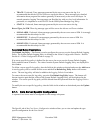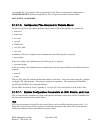for both gatekeeping and account validation. If multiple Gatekeepers are configured, then any Gatekeeper
may be contacted for account validation requests.
Note: If a Gatekeeper is configured, then it will either need to be running or marked non-executable for
HPSS Client API requests to succeed in the Core Server (even if no Gatekeeping nor Account Validation
is occurring); this is due to the HPSS Client API performing internal accounting initialization.
For a detailed description of the Gatekeeper, please refer to the HPSS Installation Guide, Section 3.7.3:
Gatekeeper.
Field Descriptions
Default Wait Time. The number of seconds the client must wait before retrying a request. This value
must be greater than zero and is used if the Gatekeeping Site Interface returns a wait time of zero for the
create, open, or stage request being retried.
Site Policy Pathname (UNIX). The contents of this file will be defined by the site and should be
coordinated with the Gatekeeping Site Interface . For example, a site may want to define the types of
requests being monitored, the maximum number of opens per user, and/or a path name to a log file. The
Site Policy Pathname will be passed to the gk_site_Init routine upon Gatekeeper startup. If a site wishes
to make use of the Site Policy Pathname file, then the site will need to add code to the Gatekeeping Site
Interface library to read the Site Policy Pathname file and interpret the data accordingly. Refer to the
HPSS Programmer's Reference, Chapter 4: Site Interfaces for details on the site's interface library.
5.1.3. Location Server Additional Configuration
The Location Server does not have a specific server configuration in the Server Configuration window.
However, some additional configuration outside SSM is required whenever a Location Server is added or
modified. Each client application which accesses HPSS must first contact the Location Server using the
Location Servers's RPC endpoints, which must be listed in the /var/hpss/etc/ep.conf file to be available to
client applications. The hpss_bld_ep utility reads the Location Server configuration and creates the
ep.conf file. Refer to the HPSS Installation Guide, Appendix F: /var/hpss files for more information on
the ep.conf file.
The hpss_bld_ep utility must only run on the HPSS root subsystem machine. To invoke the utility:
% /opt/hpss/config/hpss_bld_ep -v -f /var/hpss/etc/ep.conf -r
<Unix/LDAP Realm Name> -c <schema name> -d <DB2 configuration
database> add
For example:
% /opt/hpss/config/hpss_bld_ep -v -f /var/hpss/etc/ep.conf -r
hpss.acme.com -c hpss -d cfg add
HPSS Management Guide November 2009
Release 7.3 (Revision 1.0) 99


















